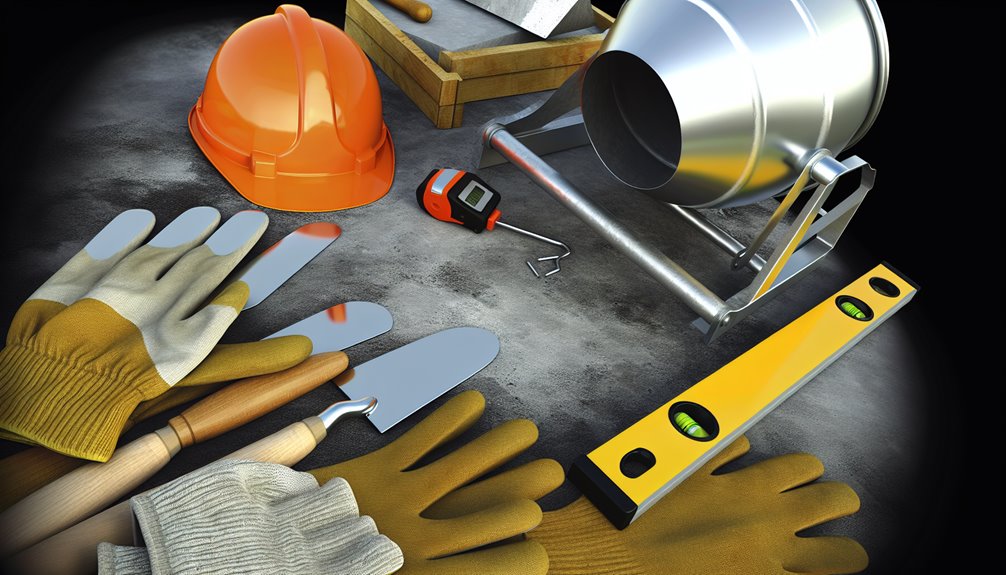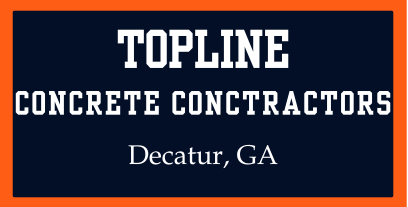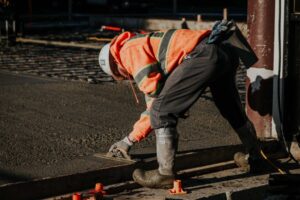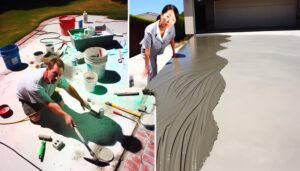
As a concrete contractor, you know that the right tools and equipment can make all the difference in achieving a successful project. From essential hand tools like trowels to concrete mixers that streamline your workflow, each item plays a vital role in your daily operations. You also can't overlook the importance of safety gear and precision measuring tools. Understanding what to invest in can enhance your efficiency and elevate the quality of your work. But before you make any decisions, it's worth considering which specific tools will truly set you apart in a competitive market.
Essential Hand Tools
When tackling concrete projects, having the right hand tools at your side can make all the difference in achieving a professional finish. Among these tools, various hammer types are essential. A framing hammer is perfect for driving in nails and shaping materials, while a rubber mallet is ideal for delicate tasks where you want to avoid damage.
Don't forget a masonry hammer; it's specifically designed for breaking up or shaping concrete.
Beyond your choice of hammers, maintaining your hand tools is vital. Regularly inspect your tools for wear and tear, and keep them clean. A simple wipe-down after each use can prevent rust and prolong their lifespan.
Make sure to tighten any loose handles and replace worn-out parts promptly.
Additionally, organizing your tools will save you time on the job. Store them in a toolbox or on a pegboard, ensuring you can easily access what you need.
Concrete Mixing Equipment
When it comes to mixing concrete, choosing the right equipment is essential.
You'll want to explore the various types of mixers and understand the best mixing techniques for your projects.
Plus, don't forget to take into account safety precautions to protect yourself while working with these tools.
Types of Mixers
Choosing the right type of mixer is essential for any concrete contractor looking to achieve quality results. You'll find two popular options: portable mixers and drum mixers.
Portable mixers are fantastic for smaller projects or tight spaces. They're lightweight and easy to transport, allowing you to mix concrete on-site without hassle. These mixers typically feature a tilting drum, enabling you to pour the concrete directly where you need it. If you often work on residential jobs or smaller commercial sites, a portable mixer can save you time and effort.
On the other hand, drum mixers are ideal for larger-scale jobs. They usually have a larger capacity, making them perfect for mixing substantial amounts of concrete quickly. These mixers operate by rotating a drum, mixing the concrete thoroughly as the drum turns. If you're working on big construction sites or projects requiring consistent quality and volume, a drum mixer should be your go-to choice.
Ultimately, the choice between portable and drum mixers depends on your specific job requirements. Assess your needs carefully, and you'll be well-equipped to select the mixer that best suits your projects.
Mixing Techniques Explained
After selecting the right mixer, understanding effective mixing techniques is vital to achieving a strong and durable concrete mix. You'll want to familiarize yourself with various mixing methods like batch mixing and continuous mixing to find what works best for your project.
Batch mixing is ideal for smaller jobs, allowing you to measure exact amounts of materials for each batch. It's important to maintain consistent water ratios during this process, as too much or too little water can compromise the integrity of your mix.
On the other hand, continuous mixing is suited for larger projects, where efficiency is critical. This method combines materials on the go, keeping the mix uniform and reducing waiting time between batches.
Regardless of the method, always make certain your mixer is clean to avoid contamination, which can affect the performance of your concrete.
Additionally, be attentive to the mixing time. Over-mixing can lead to a weaker mix, while under-mixing mightn't fully integrate the components.
Safety Considerations in Mixing
Safety is paramount in concrete mixing, as even minor oversights can lead to serious accidents. When you're mixing concrete, it's crucial to recognize the mixing hazards involved. These can include exposure to harmful dust, slips and falls, and the risk of machinery-related injuries.
To mitigate these risks, you should always wear appropriate personal protective equipment (PPE). This includes gloves, safety goggles, and a dust mask to protect against inhaling harmful particles.
Verify that your mixing area is well-ventilated to reduce dust accumulation and improve air quality.
Additionally, be cautious with your mixing equipment. Always follow the manufacturer's guidelines, and make sure your machinery is well-maintained.
Before starting a mixing operation, inspect your tools to confirm they're in proper working condition.
Finishing Tools
When it comes to finishing your concrete projects, having the right tools is vital.
You'll need essential troweling equipment to achieve a smooth surface, along with options for creating different textures.
Don't forget to stock up on edging and joint tools to guarantee clean, professional-looking results.
Essential Troweling Equipment
Troweling equipment is vital for achieving a smooth, professional finish on concrete surfaces. As you work, you'll encounter various trowel types, each designed for specific finishing tasks. For instance, hand trowels are great for smaller areas, while power trowels can cover larger expanses more efficiently. Understanding which tool to use is essential for the quality of your work.
When it comes to troweling techniques, timing is everything. You need to start troweling after the concrete has set but before it hardens too much. This window allows you to manipulate the surface effectively.
You'll find that using a fresno trowel helps in producing a flat surface when you're finishing larger slabs.
Don't forget about edging tools, which are significant for creating clean joints and preventing chipping. Using a combination of these trowel types and mastering troweling techniques will guarantee that your concrete projects look polished and professional.
Investing time in learning how to use your troweling equipment properly will pay off in the long run by enhancing the durability and appearance of your finished surfaces.
Surface Texture Options
For creating unique surface textures on concrete, the right finishing tools make all the difference. You'll find that various tools can help you achieve desired surface designs, enhancing both aesthetic appeal and functionality.
One essential tool is the float, which smooths the surface while allowing for some texture application. Using a magnesium or aluminum float can help achieve a polished finish, while a broom finish can be created with a simple broom or brush. This technique not only provides a non-slip surface but also adds character to your work.
You might also consider using stamps or stencils to create intricate patterns. These tools allow you to imprint designs into the wet concrete, adding depth and interest to your projects.
For a more rustic appearance, you can use a concrete grinder to expose aggregates, delivering a natural look.
Edging and Joint Tools
Edging and joint tools are essential for achieving clean, professional finishes on your concrete projects. These tools help you create defined edges and proper joint placement, which not only improves aesthetics but also enhances durability. When you use edging techniques, you can prevent chipping and cracking, guaranteeing your work stands the test of time.
One of the most common tools you'll need is an edging trowel, which allows you to smooth and shape the edges of your concrete. A good quality trowel will help you achieve that perfect, rounded edge that distinguishes a professional finish from an amateur one.
Additionally, joint tools are critical for creating control joints, which manage cracking due to temperature changes and settling. When placing joints, remember the spacing guidelines—typically, joints should be placed every 4 to 6 feet, depending on the slab thickness.
Safety Gear
When working with concrete, prioritizing safety gear is vital to protect yourself from potential hazards on the job site. You should invest in high-quality personal protective equipment (PPE) to minimize risks.
Start with a hard hat to shield your head from falling objects, and guarantee you wear safety glasses to protect your eyes from dust and debris.
Don't forget about gloves; they'll keep your hands safe from concrete burns and cuts. Choose durable, cut-resistant gloves that allow for dexterity while handling tools.
Steel-toed boots are a must, as they'll guard your feet against heavy materials and equipment.
Additionally, wearing a high-visibility vest enhances your presence on site, ensuring that others can see you, especially in busy environments.
Hearing protection is also essential, particularly when working with heavy machinery that generates loud noise.
Lastly, be aware of the specific hazards in your environment, and adjust your gear accordingly. Having a solid understanding of hazard awareness can help you make informed choices about your safety gear.
Measuring and Layout Tools
Accurate measuring and layout tools are vital for any concrete contractor aiming to deliver high-quality work. You need to guarantee that your projects are level, straight, and precisely aligned.
One of the most indispensable tools is the laser level. This device projects a straight line across your workspace, allowing you to easily set forms and guarantee everything is level. It saves time and reduces the chances of costly mistakes.
Chalk lines are another must-have tool for your layout tasks. This simple yet effective tool helps you create straight lines over longer distances. Just snap a chalk line between two points, and you'll have a visible guide for your concrete pouring. It's quick and easy, guaranteeing that your work is neat and professional.
In addition to these, a high-quality measuring tape is essential for accuracy when measuring distances and dimensions.
Combine these tools with a reliable square for guaranteeing right angles, and you'll have everything you need to lay out your projects with confidence. Investing in these measuring and layout tools will pay off in the quality and precision of your finished work.
Heavy Machinery
Heavy machinery plays an essential role in the efficiency and effectiveness of concrete projects. When you're tackling large jobs, having the right heavy machinery can make all the difference.
Excavation equipment is critical for preparing the site, allowing you to dig, grade, and move large amounts of soil quickly. For deeper foundations or extensive landscaping, excavators and backhoes are your best friends. They save you time and labor costs, guaranteeing you can focus on the concrete work itself.
Once the site is prepared, compaction tools come into play. Properly compacting the ground is essential to prevent settling and guarantee a stable foundation for your concrete.
Using a plate compactor or a roller can help you achieve the density needed, especially in areas with loose soil. These machines not only enhance the durability of the surface but also improve the overall quality of your work.
Frequently Asked Questions
What Are the Best Brands for Concrete Tools and Equipment?
When you're looking for the best concrete brands, consider industry favorites like Milwaukee, Bosch, and DeWalt. Tool brand comparisons reveal that these companies consistently deliver quality, durability, and performance that can elevate your concrete projects.
How Do I Maintain My Concrete Tools for Longevity?
To maintain your concrete tools for longevity, regularly clean them after use to remove debris. Apply rust prevention treatments to protect metal parts, ensuring they stay in top condition and last longer in your projects.
What Is the Average Cost of Concrete Contractor Tools?
The average cost of concrete contractor tools varies widely. Cost factors include tool quality, brand, and features. Investing in higher-quality tools can save you money over time, as they tend to last longer and perform better.
How Often Should I Replace My Concrete Equipment?
You should assess your equipment's lifespan regularly. Generally, replace your concrete tools every 3-5 years, depending on usage. Keeping an eye on replacement frequency guarantees you maintain efficiency and safety in your projects.
Can I Rent Concrete Tools Instead of Buying Them?
You can definitely rent concrete tools instead of buying them! Renting offers advantages like cost savings and flexibility. Just consider your project needs, rental rates, and tool availability to make the best decision for your situation.
Conclusion
In summary, equipping yourself with the right tools and equipment is essential for any concrete contractor. From fundamental hand tools and concrete mixers to safety gear and precise measuring devices, each item plays a significant role in delivering quality work. Don't overlook the importance of heavy machinery for larger projects, either. By investing in these must-have tools, you'll enhance your efficiency, guarantee safety, and ultimately achieve outstanding results in every concrete job you tackle.





